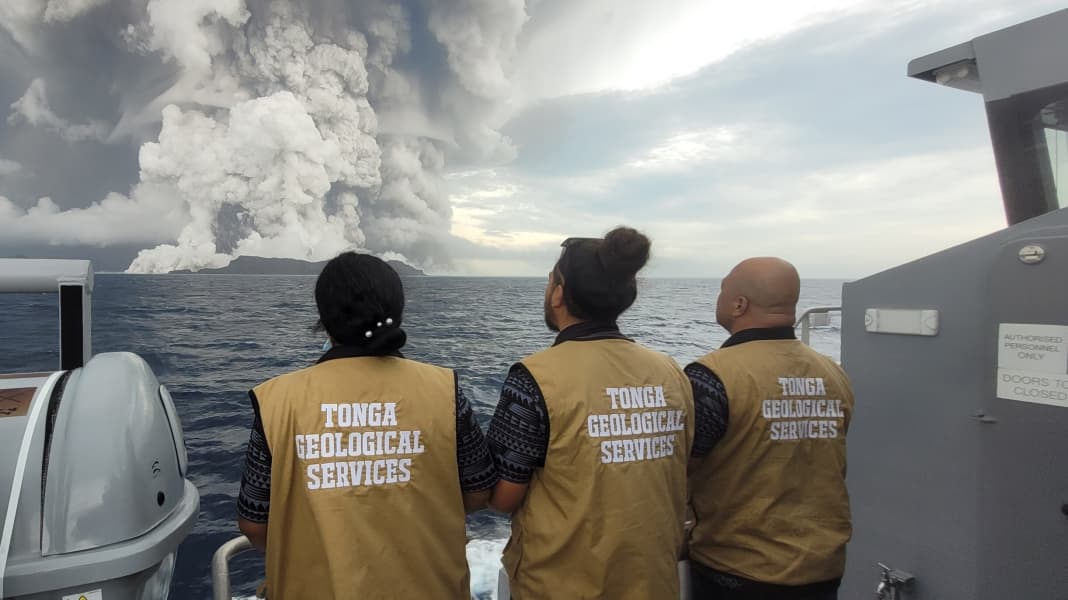
Almost a week after the eruption of the volcano in Tonga, the Pacific state is still largely cut off from the rest of the world. Satellite images and information gathered by rescue units during overflights of the islands over the past few days provide information on the situation in the island state. According to the images, entire villages on the islands closest to the volcano have sunk under layers of ash or been washed away by violent tidal waves. Three people have been reported dead so far. The undersea cables were apparently ruptured as a result of the eruption and Tonga airport was unusable for days. The volcanic island itself sank into the sea during the eruption.
Accordingly, information about or from sailors from the directly affected Pacific region is also scarce. The German long-distance sailing association Trans Ocean has announced that its base manager from Tonga is currently in Germany with her husband and has not yet been able to make contact with her home country.
The World Cruising Club, organiser of sailing rallies all over the world and operator of blue water sites on the internet, has apparently not yet received any information from sailors in the Pacific either. So far, the Noonsite homepage only refers to public news sources reporting on the natural disaster.
The effects of last Friday's volcanic eruption were felt in almost all Pacific coastal states. YACHT employee Karen Eriksen in Sydney reports that beaches on the east coast of Australia were closed for fear of a major tsunami and the inhabitants of two offshore islands were evacuated to higher ground. However, nothing happened, only slightly higher waves were registered. The highest off Norfolk Island reached 1.27 metres.
The impact was somewhat stronger in New Zealand. There it hit the harbour of Tutukaka, north of Auckland, which is located at the head of a bay. Initially, the water was apparently sucked out of the bay before flowing back with force. Several jetties, pontoons and boats were damaged.
But apparently nothing worse has happened in New Zealand. YACHT author Sabine Willner, who is currently travelling New Zealand by land with her husband while their "Atanga" is ashore in a shipyard in Whangarei, reports: "Sailing friends who anchored in the Bay of Islands told us about unusual currents. It was strange, but not frightening."
Sabine Willner can also give the all-clear regarding the long-distance sailing scene in more distant South Sea regions such as French Polynesia or Fiji. She told YACHT: "All the sailors we asked there told us that things had remained calm. Even a cyclone, which caused three metre waves and downpours at the same time, probably only caused a restless night for the local sailors. And the other island states still have entry bans due to coronavirus, so there are hardly any sailors there."
The tidal waves made it to the other side of the Pacific, to the coasts of America. There are reports from the USA and Peru, among other places, of isolated flooding with considerable damage in some cases. Regions such as the coast of California, on the other hand, escaped unscathed; the offshore islands there took the force of the waves. According to the US sailing media, boaters in the Bay Area, for example, had a perfect day on the water. Elsewhere, however, jetties were flooded and boats were swept away here and there.
The eruption of the volcano was one of the largest in recent human history. James Garvin, chief scientist at NASA, estimates the resulting forces at ten megatonnes. "That's 500 times the explosive force of the Hiroshima atomic bomb." It was also the most deafening event in the last hundred years and the second loudest in living memory. The US geophysicist Michael Poland says that the bang associated with the volcanic eruption could still be heard in Alaska. A louder bang had previously only been recorded during a volcanic eruption in Indonesia in 1883.

